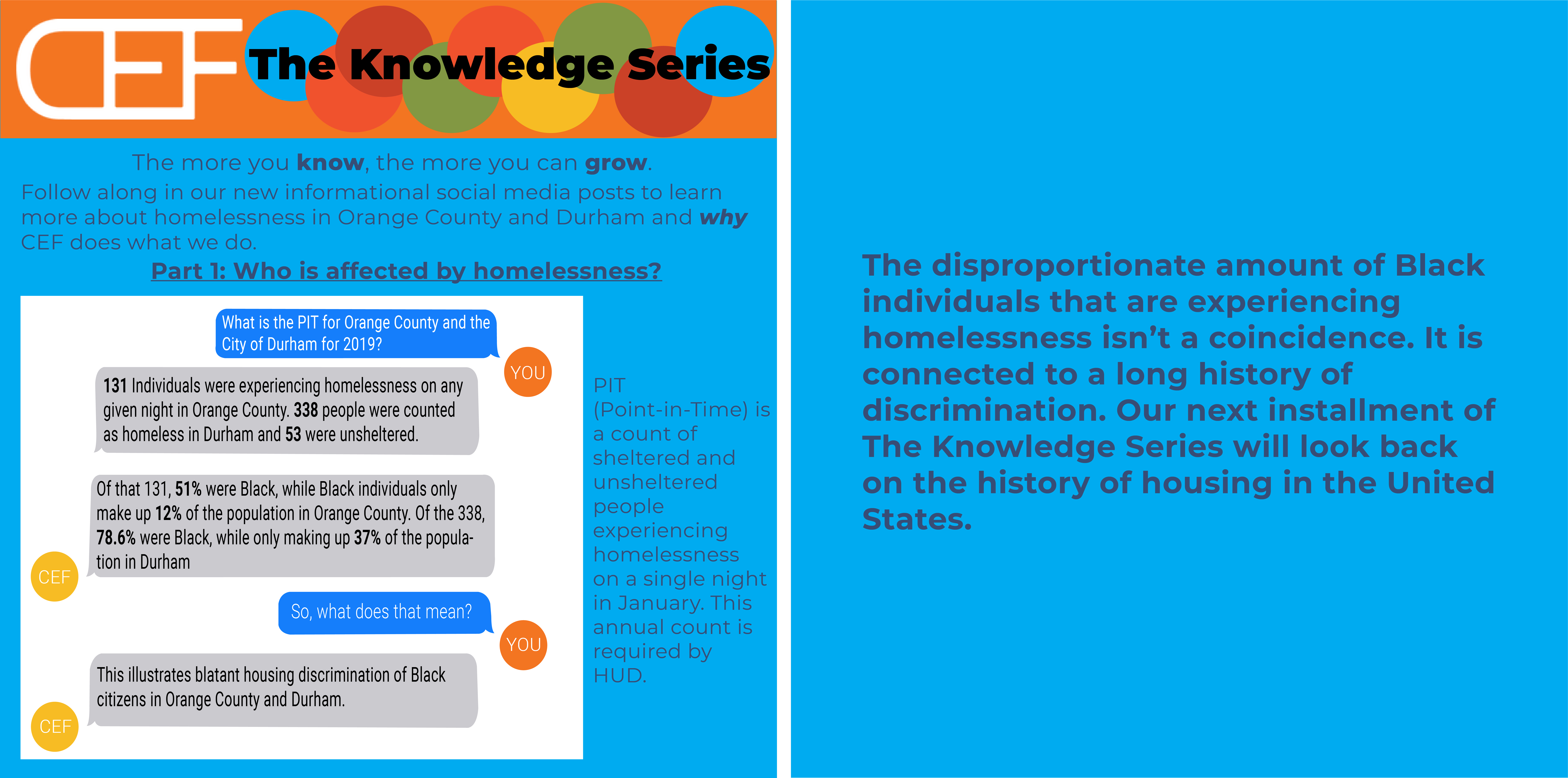The Knowledge Series is a project dedicated to sharing information with our communities on how housing discrimination manifests today. Throughout this week, we will share a series of posts that delve into the history of housing discrimination and what it looks like in our everyday.

Part 1: Who is affected by homelessness?
Every year in the U.S., communities receiving funding from the McKinney-Vento Act (a U.S. policy that provides federal funds for homeless shelters and other homelessness programs) are required to hold a Point-in-Time (PIT) count in the last week of January to tally all sheltered and unsheltered individuals experiencing homelessness in their area. Data from the most recent PIT counts show there are a projected 9,268 people experiencing homelessness throughout North Carolina. In 2019, the PIT count in Orange County revealed that 131 individuals experienced homelessness on any given night. In the City of Durham, the PIT count revealed 338 individuals experienced homelessness every day in the city.
These numbers are disheartening because at CEF we believe that housing and financial security are human rights. Unfortunately, these rights have not been previously available for many Black, Indigenous, and People of Color (BIPOC). Today, Black folx are still discriminated against in the housing and employment processes at greater numbers than any other racial group. In taking a deeper look at PIT count data, the numbers show us explicitly that Black people in the U.S. face racial and systemic barriers to obtaining housing and financial security.
Of the 131 individuals experiencing homelessness in Orange County, 51% are Black, despite making up only 12% of the population. Of the 338 homeless in Durham, 78.6% are Black, while making up only 37% of the population. These outrageously disproportionate percentages of homelessness for Black residents of Orange County and the City of Durham are a clear example of the systemic racism which has historically and explicitly barred Black families from accruing wealth through property ownership. The systems which discriminate against Black folx still have a significant impact on communities today, because of the generational trauma garnered through slavery, the Jim Crow South, and the still ever-present institutional racism which is inevitable in a society whose institutions were founded by and for white* men, and only white men.

Come back tomorrow for a blog post diving more deeply into these historical policies and systems which have created modern-day disparities which we must address. We will discuss the historical impacts of slavery and the further, blatant discrimination that Black people in the U.S. faced at the hands of Jim Crow laws in the South. Flowing into modern 20th and 21st century American history, we will use these historical structures to analyze and understand how these systems still create vast disparities for Black folx in the housing and financial sectors.
*In general, CEF uses APA grammar rules in our writing. The APA says that the names of race and ethnic identities should be capitalized, as they are proper nouns. For this series, and moving forward, CEF is intentionally leaving “white” (when referring to a racial identity) lower-cased. We recognize that by capitalizing words we are giving them power and we do not want to encourage white power in any way. Unlike the AP’s explanation for why they are choosing to lower-case “white” we want to be clear that we believe white people do have a shared experience–that is one of privilege. We also believe that undoing racism is the responsibility of white people and worry that implying that white people do not have a shared experience (as the AP does) is a dangerous tactic that is aimed at discounting the responsibility that white people have in undoing racism and white supremacist culture. Ultimately, we know that race is a construct but that racial differences are not. They are real and need to be addressed directly. For any questions or clarifications around CEF’s choice of words please contact ari rosenberg (arir[at]communityef.org).
NC Coalition to End Homelessness. (2019, May). 2019 Homelessness in North Carolina. https://www.ncceh.org/media/files/files/7bd752c5/2019-nc-pit-infographic.pdf
Root, Corey. (2019, April ). Homelessness in Orange County. Orange County Partnership to End Homelessness. https://www.ocpehnc.com/point-in-time-count-data



No comments yet.